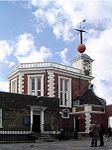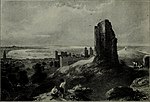Peter Harrison Planetarium

The Peter Harrison Planetarium is a 120-seat digital laser planetarium, situated in Greenwich Park, London and is part of the National Maritime Museum. It opened on 25 May 2007.The planetarium uses Digistar 3 software with blue, red and green lasers and grating light valve (GLV) technology to create a 4,000 pixel strip. This strip is swept to produce a 5,000 by 4,000 pixel image, refreshed 60 times per second. The image is projected through a fisheye lens onto the dome of the planetarium.This planetarium is housed inside a 45-ton bronze-clad truncated cone, with the north side tilted at 51.5o to the horizontal (the latitude of Greenwich), the south side pointing at the local Zenith (i.e. at 90 degrees to the local horizon) and the top being slanted to be parallel to the celestial equator. The construction stands parallel to (but 50 metres east of) the prime meridian. It was conceived under the then Director, Roy Clare CBE, as the centrepiece of the "Time and Space" project, a £17.7m re-development of the Royal Observatory, Greenwich, and funded with a £3.25m grant from the Peter Harrison Foundation.
Excerpt from the Wikipedia article Peter Harrison Planetarium (License: CC BY-SA 3.0, Authors, Images).Peter Harrison Planetarium
Blackheath Avenue, London East Greenwich (Royal Borough of Greenwich)
Geographical coordinates (GPS) Address Phone number Website Nearby Places Show on map
Geographical coordinates (GPS)
| Latitude | Longitude |
|---|---|
| N 51.4771 ° | E -0.0008 ° |
Address
Royal Observatory Greenwich
Blackheath Avenue
SE10 8XJ London, East Greenwich (Royal Borough of Greenwich)
England, United Kingdom
Open on Google Maps










